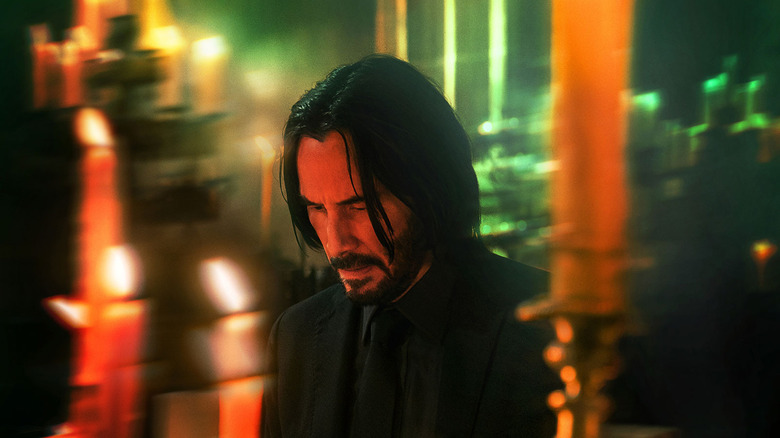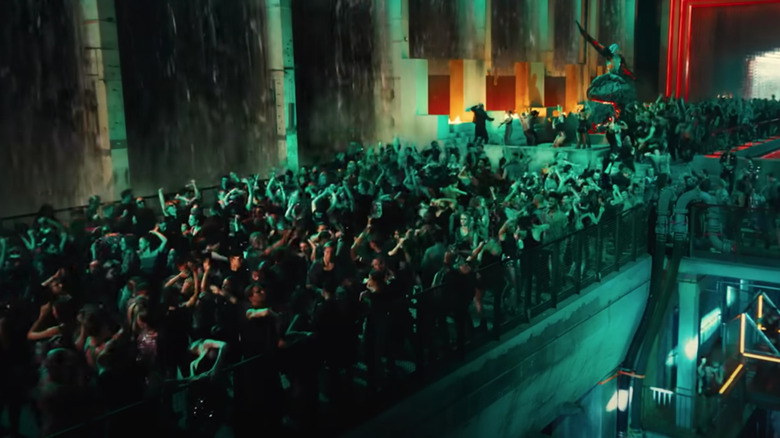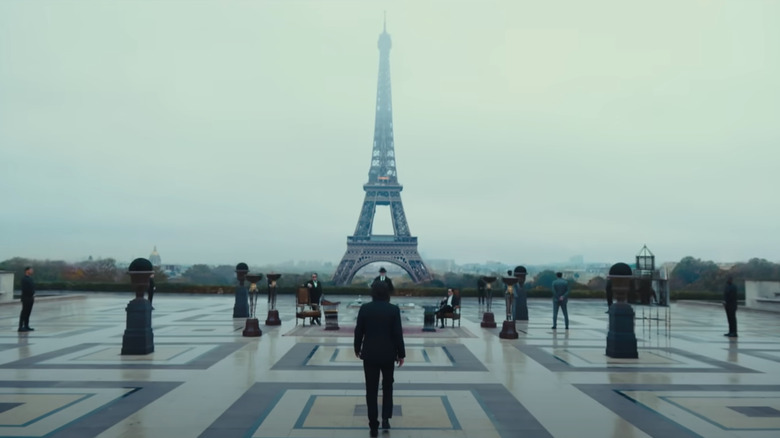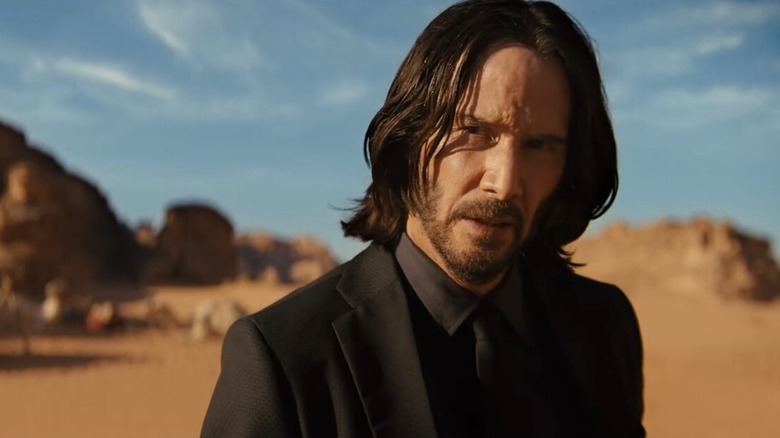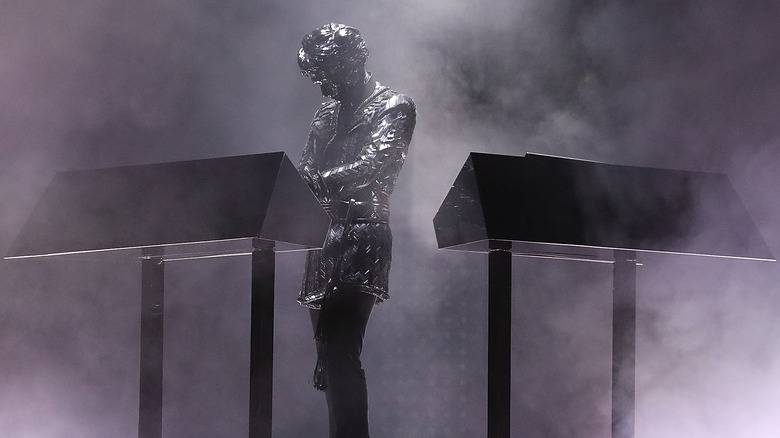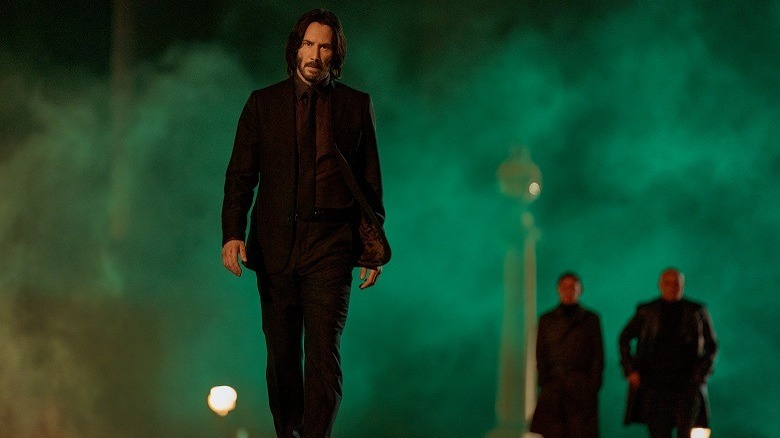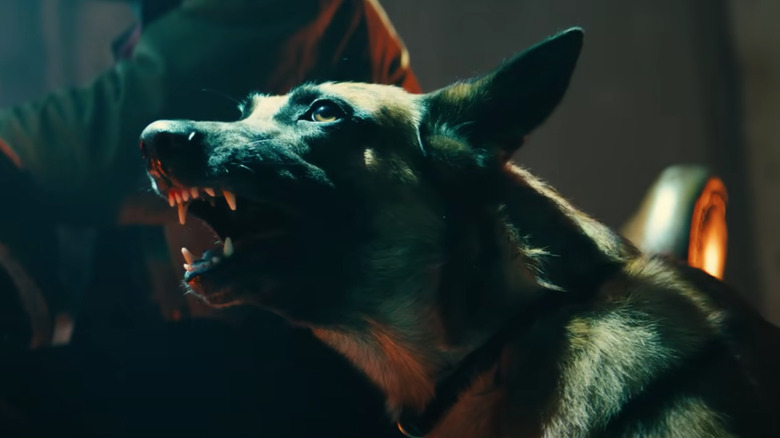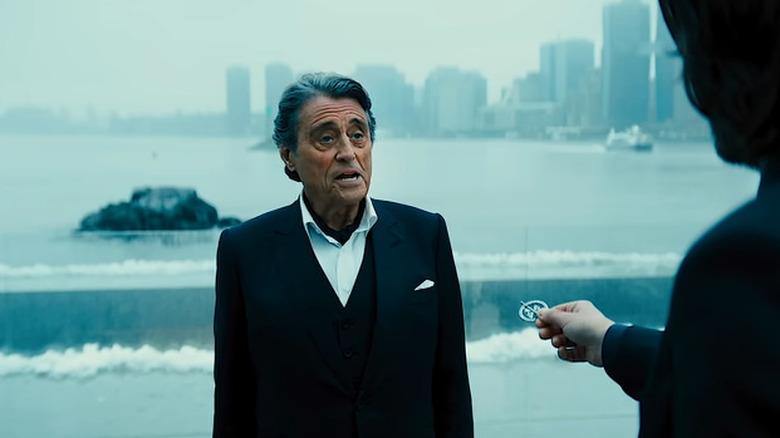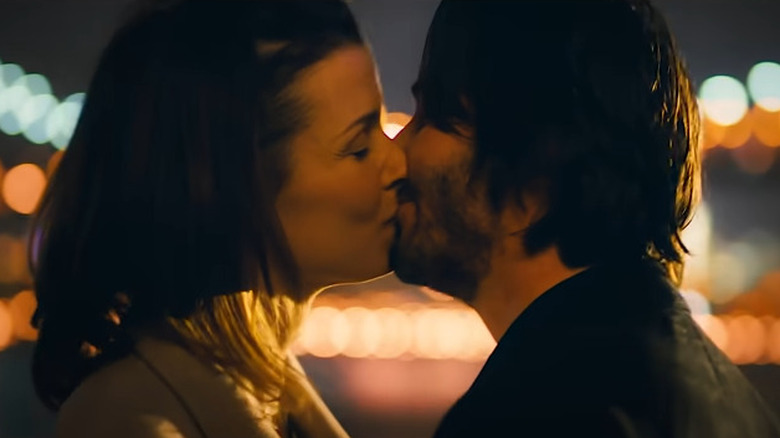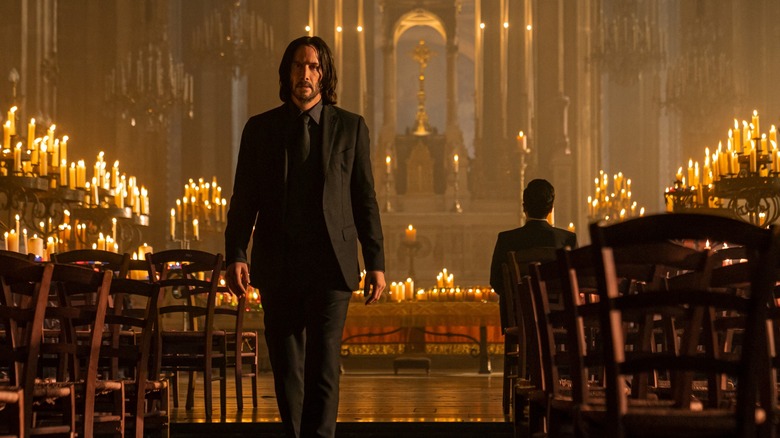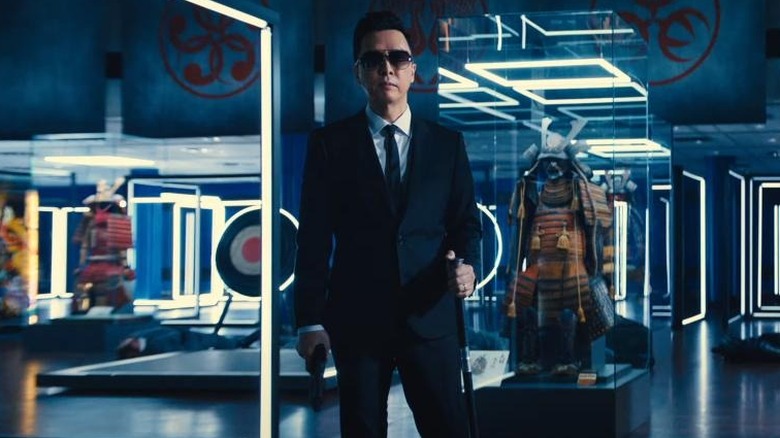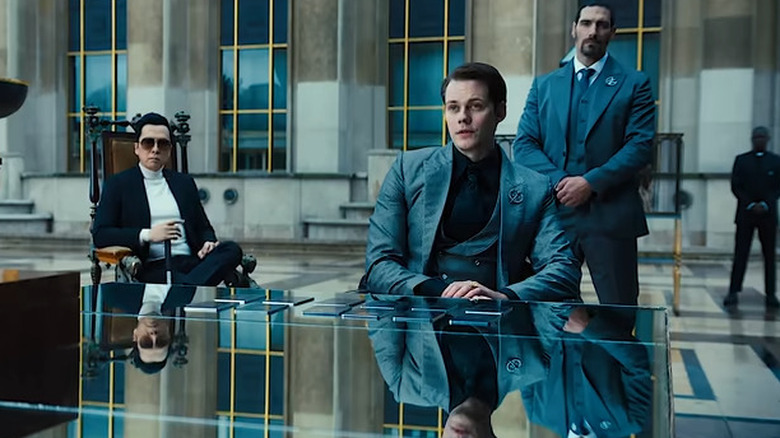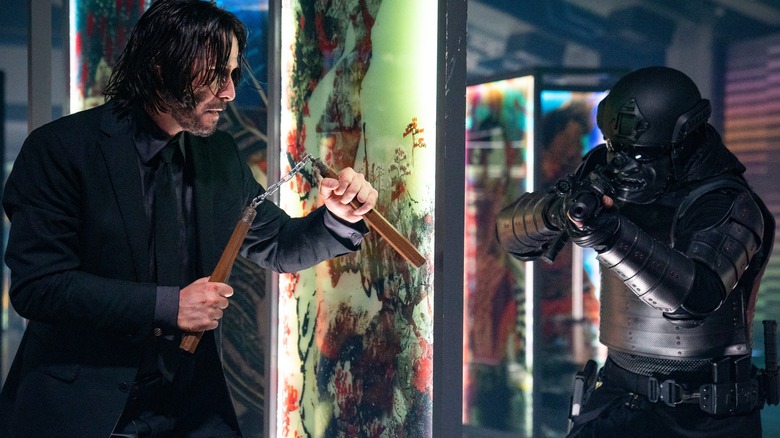The 6 Best And 6 Worst Things In John Wick: Chapter 4
Contains spoilers for "John Wick: Chapter 4"
The wait for "John Wick: Chapter 4" was a prolonged affair. The film was first slated for a May 2021 release before it was delayed by an entire year, then delayed again until March 2023. Fans of the series were left in anticipation for the next blast of action from their favorite assassin, but the wait is finally over.
The "John Wick" series began with the first movie grossing over $76 million and has continued to balloon larger and larger with every movie outperforming the last at the box office. To date — not including "Chapter 4" — the series has grossed over half a billion dollars worldwide. It would be easy for any action series to begin feeling stale by the fourth outing, but director Chad Stahelski and star Keanu Reeves have never been content to sit back and coast on past successes. Each entry needs to up the ante and find new and creative ways to escalate the action set pieces, and "Chapter 4" lives up to that tall order.
Is "John Wick: Chapter 4" worth the wait? In short: yes. With a hefty runtime and a globe-trotting story, "Chapter 4" is certainly the biggest "John Wick" movie, and some viewers might even consider it the best, but it has a few issues that hold it back alongside all of its strengths. Here are the six best and six worst things about "John Wick: Chapter 4."
Worst: Everyone is still oblivious
One element of the "John Wick" series that can prove divisive is the way it handles pedestrians. Shootouts and fight scenes throughout the franchise often take place in crowded locations packed with extras, but all these onlookers never react to the bloodshed happening right in front of them. This isn't an issue in the first film, but all of the sequels take a more heightened-reality approach to the crowds of civilians.
Several people can get gunned down close enough to them to be in the splash zone, and the civilians will just keep on dancing to the music even as bullets fly. For some, this is part of the campy fun of the series. For others, it is one step too far removed from reality to avoid breaking immersion and making the world feel artificial. It can begin to seem like there are no normal people in the world of "John Wick" and that everyone is an assassin or works alongside assassins in the underworld.
"John Wick: Chapter 4" and the other sequels would benefit from the inclusion of more characters outside of the assassination game to provide contrast. John Wick's deceased wife Helen (Bridget Moynahan) and Caine's (Donnie Yen) daughter Mia (Aimée Kwan) are normal civilians, but neither of them has a real presence. This issue makes it harder to buy into the world of "John Wick" as a functioning society with each sequel.
Best: The locations
After the relatively straightforward and simple first movie, the settings and backdrops of the "John Wick" sequels have all been impressive, varied, and well-integrated into the action set pieces. "Chapter 4" raises the bar in stunning fashion by turning the plot into a full-fledged globe-spanning adventure. New York City remains an important location in this latest outing, but the plot also finds John Wick returning to the Sahara desert of "Chapter 3" to visit the Elder, traveling to Osaka, Japan to visit a new branch of the Continental, heading to Berlin to meet with the Ruska Roma and carry out an assassination, and finally heading off to Paris to showdown with the Marquis (Bill Skarsgård). The way famous Paris landmarks like the Eiffel Tower, the Arc de Triomphe, and La Basilique du Sacré Cœur are incorporated into the action and reframed as a part of the "John Wick" world is especially impressive.
Adding to the effectiveness of the locations themselves is the way in which they are shot. The prior "John Wick" movies are no slouches when it comes to their visual aesthetics, but "Chapter 4" arguably has the best cinematography of the bunch. This latest film makes especially good use of color, bathing scenes in golden sunsets, or drowning entire environments in vibrant red and green lighting. The change from the steely, muted color palette of the first movie to the increasingly more colorful sequels is a welcome progression.
Worst: Universe inconsistencies
The unique world of the "John Wick" series is built upon and expanded with each sequel, but with that expansion comes a few inconsistencies. The first three movies mostly line up when it comes to the rules of the universe, but "Chapter 4" changes a few things up and asks you to turn a blind eye to the discrepancies. These issues might have something to do with original screenwriter Derek Kolstad being completely uninvolved with "Chapter 4" for the first time in the history of the series.
One of the biggest inconsistencies is how easy it is for John to travel this time around. A huge part of "Chapter 3" is devoted to his struggle to get from New York City to Casablanca. This requires him to secure passage from the Ruska Roma, which involves them tearing his ticket for a one-way trip. In "Chapter 4," John makes the same international journey off-screen, with no mind paid to how he gets there. His travels to Osaka, Berlin, and Paris all happen without any difficulty — despite the bounty on his head being significantly higher than ever before.
It is also unclear why John needs to go to Berlin to get the support of the Ruska Roma after he previously met at their headquarters in New York City. The complete absence of the Director (Anjelica Huston) is especially conspicuous when she seems like the perfect person to solve John's specific problem, but he instead travels to another country to meet with a brand new character.
Best: The soundtrack
The "John Wick" movies always have strong soundtracks, mixing the series' original score by Tyler Bates and Joel J. Richard with pre-existing music to great effect. Though there are plenty of memorable needle-drop moments in the previous films, "Chapter 4" has arguably the best overall soundtrack of the entire series.
Bates and Richard return as the main composers and reprise the familiar themes while ensuring the music continues to evolve and feel fresh. The needle-drop moments between the original score are a cut above the already-high bar set by the series. Fans of French electronic music will be especially thrilled as tracks from popular artists like Gesaffelstein and Justice show up — which is fitting given that a large portion of the film takes place in France. One of the best musical moments in the entire film is actually a reprise of a song first utilized in the original "John Wick." The song "LED Spirals" by Le Castle Vania makes a welcome return to the soundtrack of "Chapter 4" — after previously scoring the centerpiece shootout that takes place in the Red Circle nightclub in the first movie.
Worst: No fall damage
If there is anything that hurts the action of "John Wick: Chapter 4," it is that John feels a bit too invincible at times. Part of the joy of the first "John Wick" is how much pain he suffered and how wounded he was by the end, and yet still came out on top. Giving John a bulletproof suit in "Chapter 2" runs the risk of making him too indestructible, but the film finds a way to balance the scales and keep the sense of danger intact.
By "Chapter 4," John begins to feel a bit too superhuman. In the majority of the action sequences, this isn't a significant problem. It really only becomes a major distraction when it comes to the multiple two- to three-story falls he takes and bounces back from like they're nothing. These land in stark contrast to the fall he takes from the roof of the Continental at the end of "Chapter 3," which takes him out of commission entirely and from which he requires substantial time to rest and recover before he's ready to fight again. John takes two huge falls of a comparable size in "Chapter 4," not to mention the various other hits, stabs, gunshots, and hundreds of stairs that he falls down, but he hardly bats an eye at all the physical trauma this time around. The stakes of the action feel a little lower as a result, though the very end of the film course-corrects for the better.
Best: The dog
The "John Wick" series is almost as much about dogs as it is about action. The murder of John's puppy in the original film is, of course, the straw that breaks the camel's back and kicks off his quest for vengeance. Each subsequent movie keeps canines as a part of the series' DNA.
The unnamed dog that he took home at the end of the first film is at his side in "Chapter 2" and returns for the other sequels as well, winding up in the Bowery King's (Lawrence Fishburne) care by the end of "Chapter 4." "Chapter 3" was the first film to introduce the dogs into the action. This was done through Sofia's (Halle Berry) two attack dogs, who tear bad guys to shreds in spectacular fashion in Casablanca.
Sofia and her dogs do not return in "Chapter 4," but a new dog is brought into the action, owned by the Tracker aka Mr. Nobody (Shamier Anderson). This new dog is incorporated into the action in some creative new ways, like running and leaping across the tops of cars in a shootout set in front of the Arc de Triomphe. The best moment involving the dog is actually a choice made by John. Though the dog and Mr. Nobody have been trying to kill him, John saves the dog when she is about to be killed by Chidi (Marko Zaror). It is a perfect moment of redemption for John after what happened to Daisy all the way back in the first movie.
Worst: The cliffhanger ending was brushed aside
"John Wick: Chapter 3 — Parabellum" ends with a massive cliffhanger. After throwing away the freedom he earned from the high table to defend Winston (Ian McShane), John is double-crossed. Winston shoots him and sends him off the roof of the Continental on a multi-story crash to the alleyway down below. John is barely alive after the fall but joins up with the Bowery King. The two are both severely wounded and want revenge against Winston and the High Table.
The first three "John Wick" movies all take place within a short time span, each one beginning right after the previous one ended. For the first time, "Chapter 4" picks up following an extended gap in time after John and the Bowery King are both fully healed. Once John is back in action, he only has his sights set on the High Table, not on Winston. When the two do cross paths, John lets Winston off the hook extremely easily, and the two become chummy again and spend the rest of the film working together. The promised vengeance against Winston never happens, nor does Winston ever truly reckon with his act of betrayal. This is particularly hard to buy given that one of John's defining character traits is that he can't let things go and always needs to settle the score.
Best: Helen
John's wife Helen passed away before the start of the first movie, but his love for her and the loss that followed hangs over the entire series. The murdered puppy that kicks off the plot of the first film was especially meaningful, as it was a dying gift from her that arrived while John was in mourning. Though only brief flashes of her are shown, Helen is a substantial part of "John Wick."
"Chapter 4" brings a focus back to Helen in key moments that are quite effective and help make the series feel like it is coming full circle. Her presence is less prominent than in the first movie but far more impactful than it is in the other sequels. In one key scene, John lights a candle and pays his respects to her before having a friendly conversation with Caine about why. John says he doesn't believe she can hear him or feel his presence, but he does it anyway because he could be wrong.
John's most vulnerable and human moment in the entire film arrives when he tells Winston that he wants his epitaph to read "loving husband." He's an infamous assassin with a legendary reputation, yet he only wants to be remembered in relation to Helen. And finally — SPOILER ALERT — the quick flash of Helen in John's dying moments is a beautiful way to tie it all together and provide a fitting conclusion to Mr. Wick's journey.
Worst: John's motivation
The first "John Wick" movie has a phenomenal reason for its titular character to embark on a path of destruction: revenge for his slain puppy. "John Wick: Chapter 2" doesn't have a hook quite so strong, but it does still provide John with plenty of motivation. Fulfilling his end of the marker and subsequently getting revenge against Santino D'Antinio (Riccardo Scamarcio) gives John a clear goal to work toward in typically violent fashion.
"Chapter 3" is the first time where John's motivation starts to falter. When simply trying to survive with the massive bounty on his head, his goal is clear. His motivations became significantly weaker when he throws away everything he fought, bled, and gave his finger/wedding ring for in the end, rendering most of the plot pointless.
"Chapter 4" is another step down in the motivation department, as John doesn't really have a good reason for the bloodshed at all this time around. Other characters say as much within the film. Winston tells John that what he's doing is pointless and won't accomplish anything, and he's right. The Marquis calls John a man with nothing to live for, nothing to die for, and nothing to kill for, and he's also right. The film embraces this emptiness in John, but it is a genuine problem with the central figure. John barely feels like a character anymore in "Chapter 4" and is mostly just a vessel for other characters to exploit, try to kill, and get killed by.
Best: The new characters
"John Wick: Chapter 4" introduces many new characters to the series, and they are all great. The new characters are more interesting and compelling than the returning characters, which could be considered a major problem. Shamier Anderson as the Tracker; Marko Zaror as the Marquis' main henchman, Chidi; Clancy Brown as the Harbinger; Hiroyuki Sanada as the manager of the Osaka Continental Shimazu; Rina Sawayama as his daughter, Akira; and especially Donnie Yen as Caine are all fantastic additions to the "John Wick" world.
As the blind assassin with a friend-turned-begrudging-foe relationship with John, Yen steals the show from Keanu Reeves and nearly begins to feel like the main character himself at points as he takes center stage for stretches where John is absent. The post-credits scene teases that he actually might become the protagonist of his own spinoff at some point in the franchise's future, which sounds fantastic in theory.
As the main villain of "Chapter 4," the Marquis' reasons behind his actions are perhaps a little vague and unconvincing, but Bill Skarsgård turns in an effective performance and makes the character a worthy antagonist for the series. Scott Adkins also gives a good performance as Killa, the Berlin gangster and assassin. The British martial artist makes quite a transformation as he puts on a German accent and wears a fatsuit. The only issue with this character is that his portion of the plot doesn't feel integral to the broader story being told.
Worst: The length
Each film in the "John Wick" series has gotten progressively longer, but the biggest leap comes with "John Wick: Chapter 4." This new installment is nearly three hours long and is more than an entire hour longer than the tight and efficient first film. On the plus side, the longer runtime means more action, and the film fully delivers in that category.
All the same, the hefty length is a clear hindrance. Too much of a good thing can still become exhausting. The extended Berlin portion of the plot of "Chapter 4" is where the length is the most problematic. This segment of the film is well-made but does not feel like an integral part of the overall story. A new villain is introduced and immediately killed off in the form of Killa (Scott Adkins), a fun character who unfortunately has no real purpose in the story.
John's reason for assassinating him is to get revenge for a different new character because Killa killed her father, and John needs her to give him a family crest to be able to challenge the Marquis to a duel. The machinations are clunky and don't really need to happen in the first place to reach the same end. The entire Berlin sequence could theoretically be left on the cutting room floor without affecting the story, and the overall film would be much tighter and better-paced as a result. It would also lose a couple of new characters, which would help "Chapter 4" feel less overstuffed.
Best: The action
It should come as no surprise whatsoever that the best part of "John Wick: Chapter 4" by far is the action. To avoid stagnating and getting repetitive, every "John Wick" movie has had to raise the bar and find way new ways to showcase Mr. Wick's lethal skillset. If he simply continued to shoot everyone in the head as he does in the first movie, audiences would likely have grown tired of the series long before its fourth outing. "Chapter 2" includes a larger variety of weapons and enemy types, with John needing to go toe-to-toe with comparably skilled fighters for the first time, like Ares (Ruby Rose) and Cassian (Common). "Chapter 3" brings a new focus on bladed fights and animal combat and introduces heavily armored opponents toward the end.
"Chapter 4" continues to expand the styles of action on offer by incorporating exciting new weapons like nunchucks and bows and arrows, drastically expanding on the heavily armored and dog-based combat first introduced in the previous film, and making one of its main players, Caine, a blind assassin with a unique fighting style. The introduction of Dragon's Breath shotgun shells for one spectacular sequence is a fiery way to raise the shootout bar higher than it has ever been before. "Chapter 4" has some shortcomings in the writing department, but they are easy to overlook when the action is so incredible.
